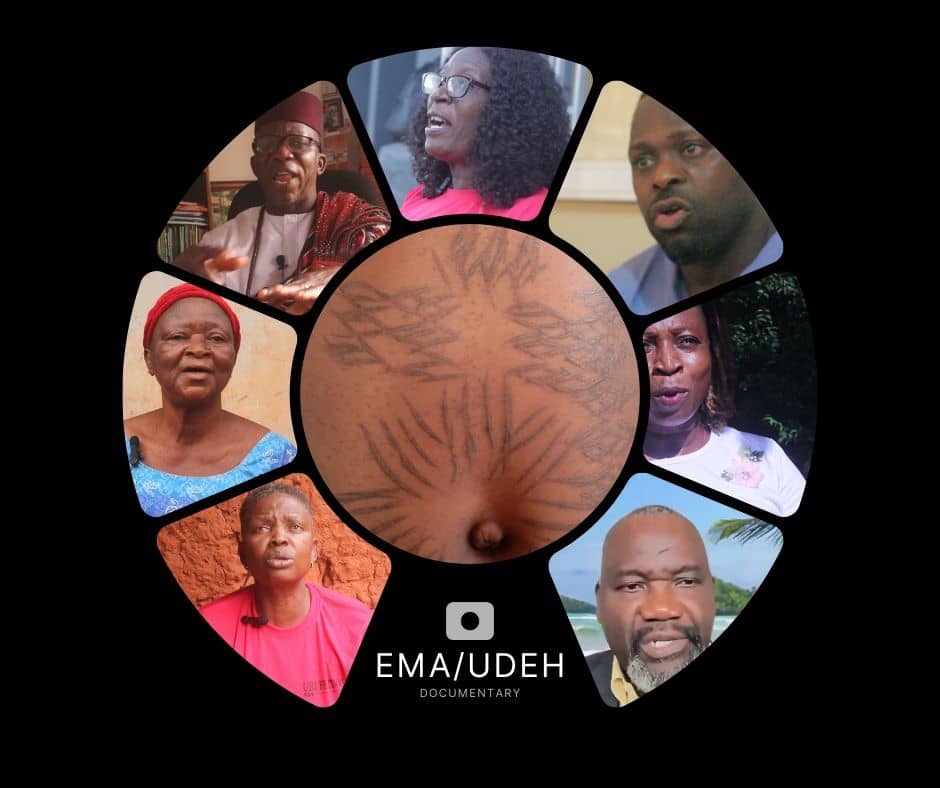
By Prisca Sam-Duru
To promote the history and rich cultural heritage of the Esan people, poet and festival administrator, Samuel Osaze, has released his new documentary film titled, ‘Ema/Udeh (Ancient Healing Tattoo of the Esan People)’.
The legacy project centers on the traditional body marking phenomenon alongside its multiple functionalities. In the film, attempts are made to depict the ancient practice without bias or prejudice questioning the practitioners and people from the town and gown.
The documentary film is now available for screening worldwide.
The contributors include university professors and orthodox medical experts, each articulating divergent views for the engagement of the public. The film aims to rouse debate over the traditional practice vis-à-vis orthodox methods. This is underlain by the conviction that such dialogues would create improvement and synergy for better-quality healthcare.
Featuring prominent academic scholars and medical experts of international repute like Professor of Dance Studies and Performance Aesthetics Mariam Asabe Iyeh, Professor of Philosophy Matthew A. Izibili, Dr. Aloja Airewele and Dr. Abel Toms-Oriakhi, the focused traditional tattoo artists are women who get involved in the practice primarily to save lives rather than making earnings. The documentary was produced and directed by Samuel Osaze, while the female Ema/Udeh tattoo artists are Justina Okoh, Martha Wilson, and Anthonia Imhanlu. Other production crew members include: Terh Agbedeh who is the director of photography and Otatane-Oso Andrew, the film editor.
The documentary film raises and answers questions about this intriguing practice. The following questions are asked; Are there grounds for comparison between the modern tattoo and the ancient Esan body marking?; How is Ema /Udeh carried out?; What could be responsible for its continuing popularity, or what does the Ema/Udeh offer that modern medical methods lack over curing the same ailment?; How genuine is the claim that splenomegaly cannot be cured by orthodox medical methods?; Is splenomegaly endemic to Esan/Edo people and if not, how do people of other ethnic groups treat the ailment?, and how could the ancient practice be improved and aligned with global standard health practices?
“Ema/Udeh does not only cure: a truth it has proved in the midst of many doubts. It also leaves carefully curated artistic footprints behind for the admiration of the bearer and the public, making the bearer a mobile canvas of the tattoo artist. Thus, the Ema/Udeh artists are able to maintain the dual functionalities of a healer and an artist, wrapped into one ball—a medical practitioner whose motivation is the wellbeing of the people. This is the point of convergence between art and medicine, exemplified by the Ema/Udeh artists of Esanland,” Osaze said.
Shedding more light, Osaze revealed that in the documentary film, Ema/Udeh is examined from four critical dimensions: Aesthetics, therapeutics, identity and spirituality, the four important functions that distinguish Ema/Udeh from the known universal usefulness of scarification.
The poet and filmmaker then opined that “Beyond medicinal, aesthetic, spiritual, and identity significations, experts have even begun to deem the practice evolutionary, feasibly moving Ema/Udeh from its present abdominal abode – where it is restricted on private exhibit for many years – to the canvas. On the canvas, the curative yet artistic patterns can be replicated for public consumption.”
Disclaimer
Comments expressed here do not reflect the opinions of Vanguard newspapers or any employee thereof.